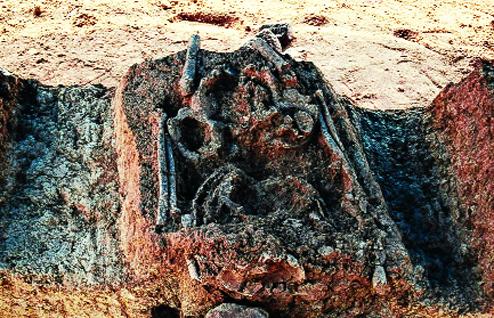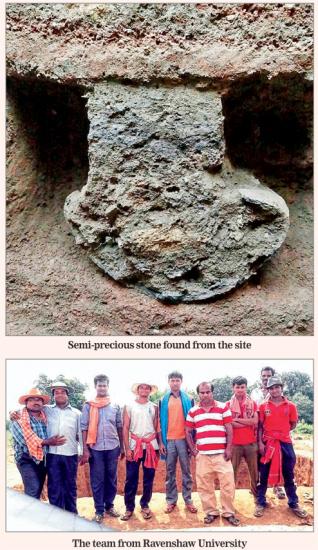Vikash Sharma
Source - http://www.telegraphindia.com/1150609/jsp/odisha/story_24615.jsp#.VXdJpt-c08o
 The trench from where the infant’s bones were found
The trench from where the infant’s bones were found
The skeleton is presumed to be dating back to the Chalcolithic Age, said assistant professor of Ravenshaw University's history department Umakant Mishra, who is also the field director for the excavation.
Archaeologists said the Chalcolithic was a phase of the Bronze Age before it was discovered that adding tin to copper formed the harder bronze. The Copper Age was originally defined as a transition between the Neolithic and the Bronze Age. However, because it is characterised by the use of metals, the Copper Age is considered a part of the Bronze Age rather than the Stone Age.
Around 10 researchers and students of the varsity are conducting the excavation at Talagada. On May 26, the team had found an adult's skeleton from the same trench. The burial ground (from where the adult skeleton had been recovered) and the fifth layer of the index trench were at the same level, said Mishra.
 The remains of the adult skeleton excavated from a Copper-Iron Age site at Talagada near Cuttack
The remains of the adult skeleton excavated from a Copper-Iron Age site at Talagada near Cuttack
The burial urn belongs to the late Copper and early Iron Age and carried cord impressed patterns, a member of the excavation team told The Telegraph today.
An expert said pottery such as the urn was used for burials. It is expected to help researchers throw more light on the lifestyle and social traditions of people during the Chalcolithic period in Odisha.
The actual age of the infant will be ascertained after the skeleton is examined at Ravenshaw University.
Apart from the skeleton of the infant, adze, an antler point, semiprecious stones, including carnelian bead, quartz and agate, have also been found during the excavation.
Mishra said the excavation had been a success because of these findings. "We will shortly submit a report on the findings and apply for permission from the archaeology department for further excavation at Talagada," he said.
"The artefacts from the trench prove that the site belongs to the early Iron Age. Iron slag have been found aplenty at the site," said an expert.
According to the circumstantial evidence, the artefacts are nearly 4,000-year-old. During the excavation, researchers have unearthed stone tools, pottery and animal bones from the site.
Earlier, the varsity's history professor Subrat Acharya, who is also the director of the excavation, had said: "We have engaged research scholars and postgraduate students in the work, for which the state culture department has sanctioned Rs 2 lakh."

 Mishra said another mound had already been earmarked for excavation on the other side of the trench from where the urn was excavated yesterday.
Mishra said another mound had already been earmarked for excavation on the other side of the trench from where the urn was excavated yesterday.
A university official said samples collected from the thigh and arm bones had been sent to the US for radiocarbon dating.
Earlier, Veena Mushrif Tripathy, a skeletal biologist from Deccan College, Pune, had examined the adult skeleton of a male. Tripathy had also recovered a turtle shell and burnished wares dating to the Chalcolithic Age near the burial ground.
Besides, within 2km of the excavation site at the village, there also lie ruins of a historic fort in a reserve forest. Earlier, copper plates belonging to the Bhoumakar rulers were also found at the nearby Patalinga village.
The recovery of skeletons and other artefacts has now become the talk of the town in Cuttack, and a lot of people are keen to know more about the findings from the excavations.
"Such findings hold significance for the entire community, because we want to know more about the lifestyle, artefacts and other credible information about the people, who used to live here thousands of years ago," said College Square resident Apurba Das.
The Pune-based expert came to the postgraduate department of anthropology, Utkal University, last year, to examine skeletons found from Baanga on the city outskirts. Three skeletons had been recovered from there during the 2013-14 excavations. Before that the Archaeological Survey of India (ASI) had unearthed a human skeleton from Golbai Sasan in 1991.